DIY Solutions for Removing Paint From Carpets
The vibrant hues bring a sense of renewal as I glance across my freshly painted living room.
But alas, a few untimely splatters found their way onto the cozy carpet below during the transformation. To prevent this from happening in the future, consider using drop cloths or plastic sheets to cover your carpet before starting any painting projects.
While paint breathes new life into walls, it can also be the bane of soft furnishings. While these DIY methods can be effective for small paint spills, larger or more stubborn stains may require professional cleaning services. It’s always best to assess the situation and your capabilities before attempting DIY solutions.
Take heart, for you can confront those vibrant blemishes with some know-how and household supplies. As a homeowner, you can master this challenge and restore your carpet’s pristine condition.
Keep reading to discover my tested strategies for liberating your carpets from the clutches of unwanted paint.
Start With the Basics: Blotting Fresh Paint Spills
Embarking on a mission to rescue your carpet from an unexpected paint spill can be daunting, yet with a strategic approach, success is close.
I always remind myself that the first step is crucial. Using a clean, dry cloth, I gently blot the problematic area.
It’s a delicate balance, maintaining enough pressure to soak up the spill without embedding the pigment further into the carpet fibers.
I stay mindful to avoid the automatic move to rub the area, which only magnifies the issue, pushing the paint deeper and risking the integrity of my beloved carpet.
Use a Clean, Dry Cloth to Gently Blot the Spill
In my experience, handling a fresh paint accident on the carpet demands swift action and the correct tool—a clean, dry cloth. By carefully pressing down on the spill, the fabric absorbs the brunt of the mess without spreading the paint further. This method has proven effective yet requires a thoughtful touch to ensure the situation doesn’t deteriorate.
Do Not Rub to Prevent Spreading the Paint Deeper
Upon discovering paint on my carpet, I’ve learned that the urge to scrub the stain away only worsens the dilemma. The aggressive rubbing can force the paint to seep into the fibers, presenting a far more complex situation. The rule stands firm whether it’s a speck or a more significant drop: blot, don’t rub, to contain the damage.
- Keep your motions gentle and dab carefully: Apply enough pressure to lift the paint, not push it in.
- Circle the spill starting from the edges inward: This minimizes paint spreading outward.
- Continuously rotate to a clean section of your cloth: This prevents applying paint to the carpet.
The Dish Soap and Warm Water Technique
Transitioning from the initial blotting, my focus often shifts towards a method that marries simplicity with efficacy—the dish soap and warm water solution.
This tried-and-tested method has rescued my carpets countless times. It’s a gentle yet potent remedy for lifting paint stains, a testament to the effectiveness of DIY solutions.
To prepare, I stir together one tablespoon of dish soap with two cups of warm water, creating a cleansing concoction perfect for tackling the stubborn remnants. If you don’t have dish soap, you can also try using a mild detergent or even baking soda mixed with water as an alternative.
Dipping a fresh cloth into this mixture, I apply it carefully to the affected area, taking care not to saturate the fibers.
With every soft dab against the stain, the paint begins to surrender to the soapy water, transferring from my carpet back onto the cloth, a testament to the combination’s effectiveness.
Mix a Tablespoon of Dish Soap With Two Cups of Warm Water
Preparation is key when addressing a paint stain, and I’ve found this concoction to be a game-changer. A tablespoon of dish soap, nothing fancy, just the regular kind from my kitchen, blended with two cups of the warmest water my tap can muster, sets the stage for an effective clean-up. Knowing that such a simple solution, easily mixed in any household, can gently coax a paint stain out of carpet fibers, reducing the blemish significantly is a relief.
Apply the Mixture Gently Onto the Stain and Blot Away
Delicacy is paramount when I apply the soapy solution to the stained carpet. I blot carefully with a soft touch and a steady hand, avoiding aggressive movements that may cause further damage. Each part with the cloth is calculated and precise to ensure that the soap solution loosens the paint’s grip without drenching the carpet’s fibers.
- Begin with a light touch, allowing the solution to access the paint stain.
- Blot in a measured, rhythmic motion to gently lift the paint from the carpet.
- Progress steadily, ensuring that the affected area is manageable.
Trying Out Glycerin for Stubborn Paint Removal
Confronting stubborn paint embedded in the fibers of your carpet can be a real challenge.
When my usual dish soap solution doesn’t fully solve the problem, I will use glycerin’s unique properties.
This viscous liquid is indispensable in my carpet rescue toolkit for softening dried paint.
With patience and the proper technique, glycerin can break down even the most tenacious paint spots, preparing them to be lifted away from your precious carpet. However, if the stain doesn’t come off completely, you may need to consider professional cleaning services or other advanced methods.
So, let’s talk about leveraging glycerin’s paint-removing prowess to restore your carpet’s former glory.
Apply Glycerin Directly to the Dried Paint Area
When faced with a paint stain firmly on the carpet, I turn to glycerin—an often overlooked but highly effective tool in my home improvement arsenal. I apply a small amount directly to the dried paint, cautious not to overdo it since a little goes a long way. Then, I patiently wait, allowing the glycerin to penetrate and soften the paint, preparing it for the final removal process.
Let It Sit Before Gently Blotting Up Loosened Paint
Patience is a virtue, especially when removing dried paint from carpet fibers. After applying glycerin, I’ve learned to let it sit undisturbed, usually for a few minutes, depending on the paint’s stubbornness. This waiting period is critical—it’s when the glycerin works its magic, slowly breaking down the paint’s molecular bonds.
- Leave the glycerin to work: This step requires no active intervention, allowing time for the glycerin to penetrate the dried paint.
- Check the softening of the paint: After waiting, I gently nudge the spot with my finger to see if the paint has softened enough for the next step.
- Transition to blotting: Once the paint feels much softer and malleable, it’s time to proceed with careful blotting to lift the loosened paint away from the carpet. After successfully removing the paint stain, it’s important to clean the affected area to ensure no residue or marks left behind. You can do this by blotting the area with a clean, damp cloth and allowing it to air dry.
Employing Rubbing Alcohol for Resilient Paint Types
Occasionally, I encounter a type of paint that stubbornly clings to carpet fibers, seemingly impervious to the usual remedies. For these resilient paint types, I turn to rubbing alcohol, a strong solvent that can break down oils and resins in paint. However, it’s important to note that rubbing alcohol is flammable and can be harmful if not used properly. I dab it sparingly onto a clean cloth and apply it to the paint, conscious of its strength and the need for caution.
My application of rubbing alcohol is measured and strategic, targeting only the paint and avoiding unnecessary contact with the surrounding carpet area. This precision helps preserve the carpet’s texture and color while efficiently lifting the tough paint. Ensuring good ventilation in the space is also a part of my process when using rubbing alcohol, as it safeguards my health and well-being during the removal endeavor.
The moment I witness the paint start to dissolve under the influence of rubbing alcohol, I carefully blot the loosened material, taking care not to spread it further. It’s a balancing act between rigorous paint removal and the gentle care of my carpet, which ultimately leaves me with a spotless surface free from the clutches of resilient paint. This method personifies a professional painting contractor’s knack for problem-solving, guaranteeing the restoration of my carpet’s original elegance.
DIY solutions for removing paint from carpets empower homeowners to swiftly address spills with practical, readily available tools like dish soap and glycerin.
These methods elevate ordinary household items into potent remedies that preserve the carpet’s integrity while tackling stubborn stains.
By understanding how to apply these substances gently and effectively, individuals can save their carpets and wallets from the strain of professional cleaning services.
Such know-how restores the beauty of one’s home and instills a sense of accomplishment and self-reliance in home maintenance.
Removing paint from carpets can be challenging but manageable with the proper techniques. Follow these DIY solutions to restore your carpet’s appearance effectively. For seamless painting and cleanup, trust Stellar Painting for professional services that ensure your home remains spotless and beautifully painted.



